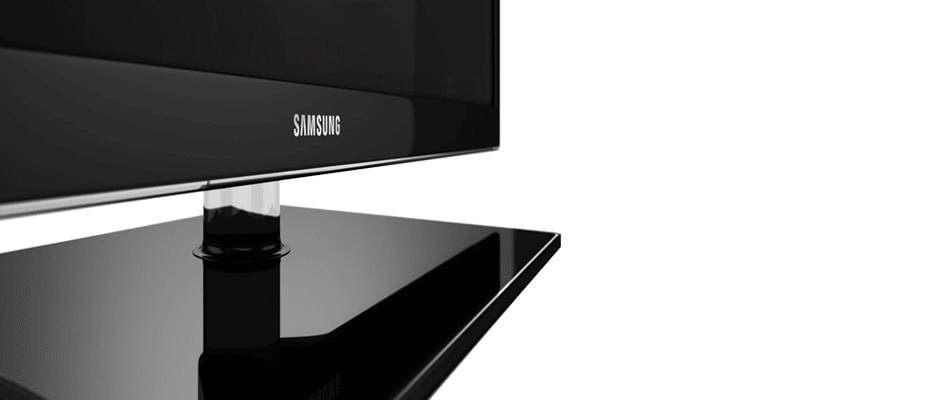Pros
Cons
Introduction
We reviewed Samsung's E530 series in May, and found that the E550, while only being $200 more expensive, is a much better deal. You get access to Samsung's well-organized internet features, 3D capability, and vastly improved motion performance, which had been a big drawback of the E530.
Design
At first glance, the Samsung PN51E550D1 appears to be a completely average plasma TV: it's got a charcoal, rectangular display panel, and a squat, hefty black stand. But a closer inspection reveals some subtle, but fairly unique, design characteristics. The PN51E550D1's stand is overlaid with a smooth, green-glossed glass. This glass then seamlessly melds into the neck of the stand, which--surprisingly--then allows for around 25° of swivel to either side. It's not like the TV floats in mid-air, but in this business, we get excited over the little things.
Like other Samsung plasmas from 2012--the E530 series comes to mind--the PN51E550D1's on-set controls are allocated to Samsung's signature jog stick, located upon the bottom, left side of the bezel. The E550's ports can be found on the back, left hand side of the TV, oriented in a rear-facing and side-facing manner. This is a standard set-up for Samsung, and we're glad they've sought to strike a balance between form and function with so many of their TVs.
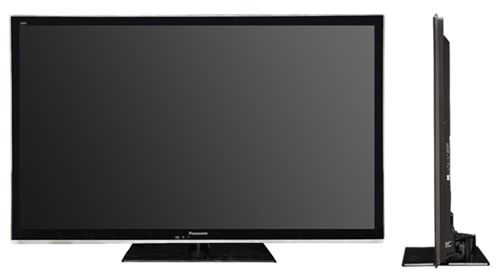
Front
{{section_header}}{{section.name}}{{/section_header}}

Back
{{section_header}}{{section.name}}{{/section_header}}

Sides
{{section_header}}{{section.name}}{{/section_header}}

Stand/Mount
{{section_header}}{{section.name}}{{/section_header}}
There's nothing too crazy about this stand, but we think the overlaid glass on the platform and glass neck that supports the TV (and swivels) is, aesthetically, a bonus for being included with a mid-range plasma.
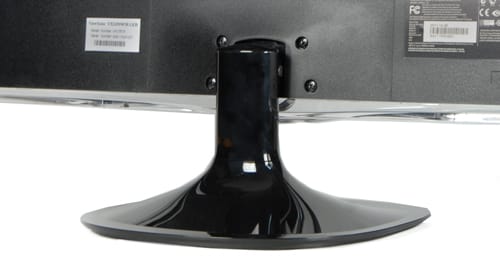
On-set Controls
{{section_header}}{{section.name}}{{/section_header}}
The E550D1's Jog Stick is a button as well as an analog stick. While the TV is powered off, pressing the button will power it on. Pressing to the left or right will change channels, up or down, respectively. Pressing to the back or front will raise/lower the TV's volume. If you press the "button" again while the TV is on, it will bring up a 4-way quick menu allowing you to go to the Smart Hub, shut the TV off, go to the TV Menu, or select your source input. The jog stick on the E550D1 is located along the bottom of its bezel, on the far left side of the TV.

Remote Control
{{section_header}}{{section.name}}{{/section_header}}
The remote control that comes standard with the Samsung PN51E550D1 is a button-heavy device that offers a big, central Smart Hub button, large raised platforms for changing channel/volume, a 0-9 number pad, and numerous "single use" style buttons for jumping directly into menu functions like closed captions, picture size, or a connected USB device. This remote is just like the standard infrared for non-3D models, save that it features a "3D" button as well, for changing 3D type. It's backlit, and feels sturdy and comfortable while held. It also seems to have above average infrared tracking, which is always a plus.
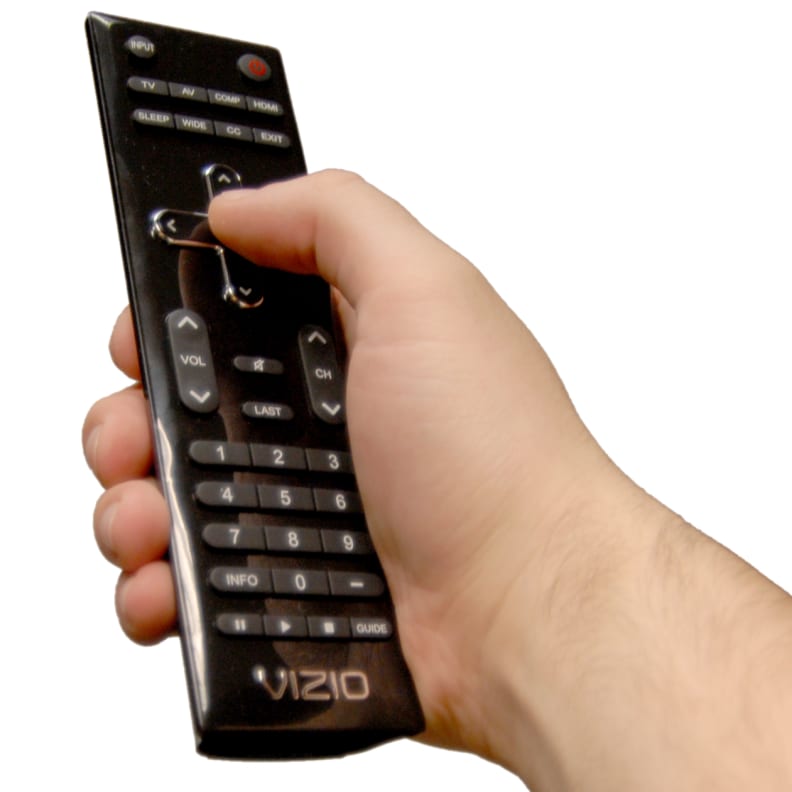
In the Box
{{section_header}}{{section.name}}{{/section_header}}
In the box, you'll find the display panel, the stand components, 8 screws, a user manual & quick set-up guide, 2 free pairs of Samsung active 3D glasses, the power cable, a handful of cable ties, the remote control, 2 AA batteries, and Samsung's warranty information.
Connectivity
{{section_header}}{{section.name}}{{/section_header}}
The Samsung PN51E550D1 offers Samsung's standard placement of side- and back- oriented ports. As a rule, the ports inclined towards the side of the TV are reserved for devices that will likely be swapped in or out often--HDMI and USB inputs, mainly. The E550 features two side HDMI ports, and two side USB inputs.
Within a recessed area on the back of the TV, you'll find traditional, semi-permanent connectivity options. The E550 has inputs for an ethernet cable (LAN), DVI (PC) audio, a third HDMI, an EX-LINK port for service updates, a shared Component/AV input, and a coaxial jack for a cable or antenna connection. Its output ports include a digital audio out for a surround sound system.
Including the stand's ability to swivel, we think this port placement is sound, and offers fairly easy access to a variety of connectivity options that will satisfy most users. However, if you think one composite input and three HDMI inputs is too scant for your array of devices, you'll find a lot more connectivity options on Samsung's Series 8 flagship.
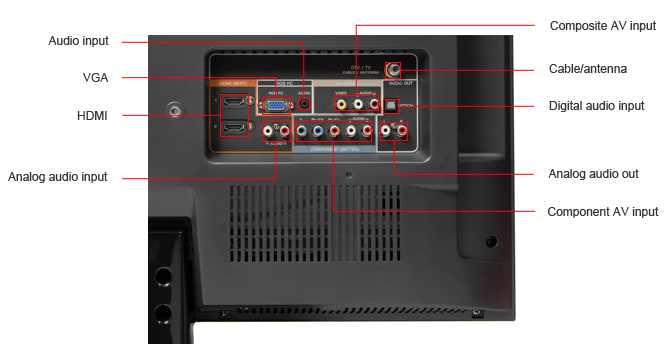
Performance
For an MSRP of $1199, the 51-inch E550 from Samsung held up to our gamut of tests and scrutiny with above average results in almost every category. While it doesn't have the largest contrast ratio this year, or the most spot-on accurate color, its combined imperfections form a very solid, reliable whole. In the area of core performance, its color and contrast are fitting, and suitable, to viewing of almost any type.
In the area of screen performance, it tested with very impressive motion, making it perfect for sports or video games. It also offers a 168° total viewing angle, which--combined with its swiveling--gives you a huge range of options as to where you view the screen from.
Samsung's included ECO mode allows for user-controlled leveling of power consumption--you can lock the cell light to particular brightnesses, and cut back on wasteful measures, ending up with a plasma that's much cheaper than similar and even more expensive models within Samsung's line-up.
The only real drawback of the E550's performance is in its audio, which relies on fairly tinny 10-watt speakers to produce audio that's a little below average.
Contrast
{{section_header}}{{section.name}}{{/section_header}}
The E550 series tested with a black level of 0.04cd/m2 , and a peak brightness of 140.86cd/m2 . This gives is a maximum contrast ratio of 3522:1, which is roughly three times what we would consider to be average or acceptable.
Compared to the E530 series, the E550 has only a marginally smaller contrast ratio due to being slightly dimmer. Comparing both with Samsung's E8000 flagship plasma series, the deep blacks boost their contrast ratios considerable. While the E550 does not have the largest contrast ratio of the three TVs we pulled for comparison purposes, its result of 3522:1 is ample black/white differentiation for most purposes. More on how we test contrast.
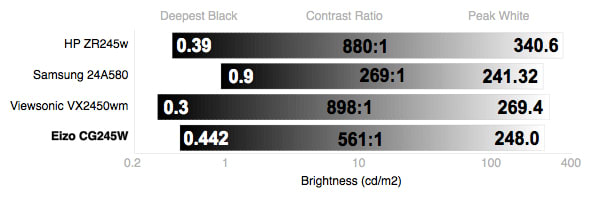
Color & Greyscale Curves
{{section_header}}{{section.name}}{{/section_header}}
At first glance, these color curves may look quite skewed and bumpy, but they're not terrible. The green, red, and blue lines representing those colors are uniform, and slope smoothly together up across the full spectrum of light input. This means that most hues within those color groups will be represented, from shadow tones to highlights (darkest to brightest). The bumpiness of the lines shows us that, occasionally, one shade of a color will not transition smoothly to the next, and will seem to jump, though the effect on standard content is mild.
The gamma line (represented here by a black line) shows the curve of input along the greyscale--black, to greys, to white. It ramps up quickly, meaning the brighter side of the input spectrum will lack detail, and the severe bumpiness towards the last 30% will cause shades of grey/white to jump somewhat rapidly to one another.
While the color curves are more or less decent, the gamma result is sub-par. This is an alright result, but we've seen much better curves from cheaper TVs this year. More on how we test color performance.
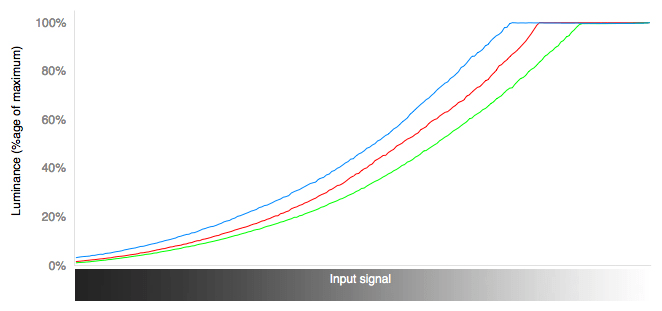
Color Temperature
{{section_header}}{{section.name}}{{/section_header}}
The chart below shows a TVs deviation from its standard color temperature, to warmer or cooler degrees. The orange/blue spikes show warm/cool respective deviations from "0," which represents the TV's majority color temperature. The green bar around most of these deviations reveals that they are not perceptible during viewing--this is a good thing. Only the darkest edge of the input spectrum contains visibly skewed color temperature, deviating into cooler degrees that become mildly perceptible during shadow tones. But for the most part, this is a good result, one we would call above average. More on how we test color temperature.
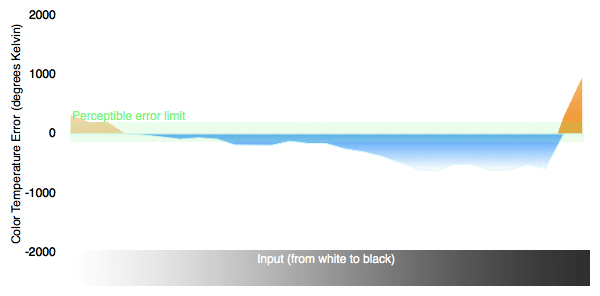
Color Gamut
{{section_header}}{{section.name}}{{/section_header}}
The gamut chart below shows two triangles. The black-lined triangle represents the ideal rec. 709 color gamut, the industry standard for measuring the red, green, blue, and white peak colors for HDTVs. The white-lined triangle shows the test result for the E550's gamut. As you can see, it's fairly accurate. Rarely do we see a perfectly matched gamut, though it's always a treat.
The gamut comparison below reveals that the E550's white point (middle circle) matches the ideal, but its red and blue points are undersaturated. Undersaturation occurs when a peak color does not contain as much "light" as it should. The green point is perfect. This is a good result, as the undersaturation of the red and blue points will not be easily visible during broadcast content. More on how we test color temperature.
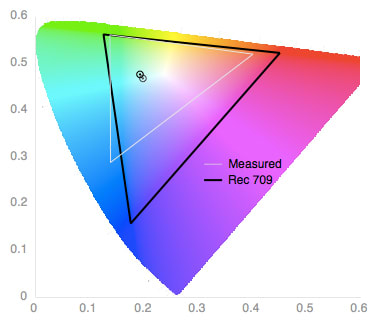
Picture Dynamics
{{section_header}}{{section.name}}{{/section_header}}
The Samsung PN51E550D1 tested with above-average picture dynamics.
For plasma televisions, whites on screen tend to grow dimmer as they take up more space on screen, so a small patch of white can (and should be) roughly twice as bright as a full white screen. Contrary to this, black or shadow colors should ideally be of the same darkness no matter how much of the screen they occupy.
The E550's white dynamicism was spot on, with a 5% patch of white measuring at 136.56 cd/m2 , and a 100% white screen measuring at 45.07cd/m2 . Yet its blacks were a little off, with a full black screen testing at 0.03cd/m2 , and a 5% black screen growing considerably brighter at 0.19 cd/m2 .
This is not a great result, but is decent, and most users won't notice these kinds of light fluctuations the way an expensive piece of lab equipment does. More on how we test picture dynamics.
Resolution & Formats
{{section_header}}{{section.name}}{{/section_header}}
The Samsung PN51E550D1 is a native 1080p, Smart, 3D, plasma HDTV. It supports all NTSC resolutions and formats.
Viewing Angle
{{section_header}}{{section.name}}{{/section_header}}
Because of their light-producing technology, plasma TVs tend to have much wider viewing angles than LCDs, and the chart below is a testament to that result.
The E550 tested with a total viewing angle of 155°, or 78° from center in either direction. This is a really good result. Compared to the E530 series, it's slightly wider, though neither mid-range plasma could hold a candela to the huge viewing angle we tested on the E8000, Samsung's flagship plasma. The P50U50, a budget TV from Panasonic, was left in the dust.
While it's not as impeccable as the E8000, this result proves that the E550 is a great choice for most rooms, and gives you ample options for viewing location--especially when you consider that its glassy stand allows it to swivel.
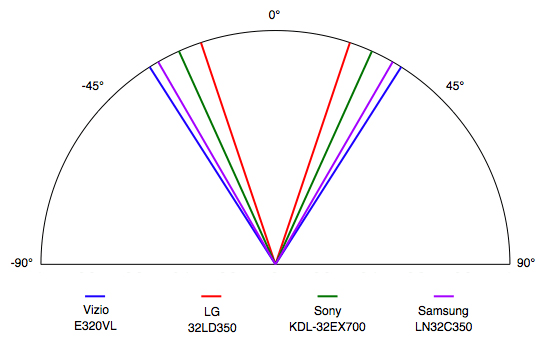
Motion Performance
{{section_header}}{{section.name}}{{/section_header}}
When we tested Samsung's E530 series a couple of months ago, we were disappointed by its motion performance. The E530A3 series is a "dumb" (read: not internet enabled) version of the E550D1, and we had been curious to see if one step higher on their series ladder would reveal improvements to things like motion performance and color integrity.
The Samsung PN51E550D1 tested with highly superior motion performance compared to the PN51E530A3, and did very well as a standalone test. It showcased almost no blurring, maintaining crisp details in things like foreground faces, aged brickwork, background framed photos, intricate metalwork, and soft shafts of sunlight. It maintained the shape integrity of squares and rectangles, and was able to smoothly slide a complex montage of pixels across its screen with only very mild artifacting, the kind that would be very hard to see during standard kinds of content.
We were impressed by the E550's motion performance. Perhaps E530 owners can upgrade at some point using Samsung's Evolution Kit. Samsung claims on their website that "Soon you will be able to update your Smart TV every year with the latest technology. Samsung's Evolution kit upgrades your Smart Evolution enabled TV without having to replace the whole set. With Increased processor speed, more functions and additional content, your TV will never be the same again." Time will tell if this update process is valuable, or not.
{{product.manufacturer_specs['Motion Performance Image']}}
Screen Uniformity
{{section_header}}{{section.name}}{{/section_header}}
The PN51E550D1 showed us fine, above average screen uniformity. We test uniformity by displaying a 100% white and a 100% black screen on the TV's display, and look for imperfections in brightness/darkness. Like most plasmas, the E550 takes advantage of an auto-dimming feature while showing an all black screen, causing it to appear to have been shut off, but this leads to very strong shadow uniformity, and even partially dark screens showed no light bleed-in. The 100% white screen was mostly uniform, with a mild shadow quality to its corners that wasn't terribly distracting. Overall, a good result.
{{product.manufacturer_specs['Screen Uniformity Image']}}
Audio Quality
{{section_header}}{{section.name}}{{/section_header}}
Like almost every modern HDTV, the Samsung PN51E550D1 makes use of two, embedded 10-watt speakers that reside along the underside of the bezel and are downward facing, meant to curve sound off of the base/table and direct it towards the viewer. The wattage of the speakers is dictated by the amount of electrical energy used to power them, and also their size and output volume. For reference, a guitarist's practice amp's speaker is often 15-30 watts, and their performance amp's speaker is usually 75 or higher.
As we've seen in the past, 10-watt speakers just don't have a lot of kick. We recently reviewed a VIZIO that housed two 15-watt speakers, and the added power made a huge difference. The E550D1 just doesn't have much "kick" to it, and its surround mode--called SRS TruSurround HD--actually made voices and softer effects more difficult to hear. Needless to say, we were disappointed, but we weren't surprised. This audio would be fine over headphones or by yourself, pretty close to the TV, but if you wanted to center a home theater hub around the E550, we behoove ye to summon yon surround sound system.
Completely average TV audio, which means sub-par audio quality.
Power Consumption
{{section_header}}{{section.name}}{{/section_header}}
When we unbox our TVs, they're often covered in plastic, and usually have stickers that say "energy efficient" or "energy saving" to mark that they ought not to cost a large yearly sum in electricity payments. The E550 was one such telly.
Oddly enough, our initial power consumption test revealed that it sucks up a lot of power, even with its peak brightness being a somewhat measly 140 cd/m2. It was maxing and averaging at about 250 watts, which is not unheard of for a 51-inch plasma, but didn't seem to jive with the "energy saving" sticker on the TV's bezel. Looking through the menus revealed that there is an "ECO" energy saving mode, which cuts back the TV's consumption considerably, but must be turned on.
The ECO mode essentially cuts the TV's light output; you can even force it to alter the cell light--sort of the backlight for plasma TVs. With the Cell Light at 20, with no energy saving mode enabled, users who use their E550 4-6 hours a day will be paying around $42 a year in electricity costs, which is right in line with the other two Samsung plasmas we compared it to (see below).
Even with the Cell Light still at 20, turning on ECO mode cuts consumption by around 100 watts, which means you save about $12 a year. ECO mode makes the E550 the cheapest plasma to power, per year, out of a lot of the 2012 plasmas we've tested thus far. Our recommendation? Turn it on, save some dough.
{{comparison_bars title="Average Cost Per Year", attribute="Minimum Recommended Cost per Year Measured", xLabel="Dollars"}}
Calibration
{{section_header}}{{section.name}}{{/section_header}}
Like many of the Samsung televisions that we've reviewed this year, the PN51E550D1 proved to be calibrated very well right out of the box. Calibrating in Movie mode, we found that Samsung's preset values for Cell Light, Contrast, Brightness, and Color were already optimized to provide maximum contrast and color performance. As usual, we turned Sharpness from 20 all the way down to 0, but left everything else alone. You can see the values for our (and Samsung's) calibration in the table below.
All of our calibration is done in conjunction with the DisplayMate software.
Video Modes
{{section_header}}{{section.name}}{{/section_header}}
The Samsung PN51E550D1 has just 3 Video Modes: Dynamic, Standard, and Movie.
3D
3D's come a long way since its initial foisting into the home television market. Like a stern grandfather, we've watched it stumble and trip while its parent companies continued to boast that it was as graceful as a gazelle. Yet 2012 has cemented a very serious truth about 3D: it can look good, and it will. But most of the time, it doesn't.
Samsung is one of the industry's leaders in HD 3D and 2D-to-3D conversion, and that shows when you're watching the E550D1. Their 3D glasses are comfortable enough, and hold a long battery charge, but they don't fit very well over a pair of standard spectacles. There's very little crosstalk at standard 3D depth. Users have the option to decrease the depth closer and closer to "3D lite," or increase the depth until they're watching some serious crosstalk. But the standard depth looks good, and Samsung's active 3D glasses maintain the viewer's sense of color and contrast fairly well while still offering a decent 3D experience.
The 3D here doesn't detract from the overall value of the E550D1 series, but take it from us, and don't buy this TV if all you want is 3D. However, if you want a sound plasma that's got the option of 3D (and Samsung's grade A Smart Hub), you could certainly invest in pricier TVs that didn't bring as much to the table.
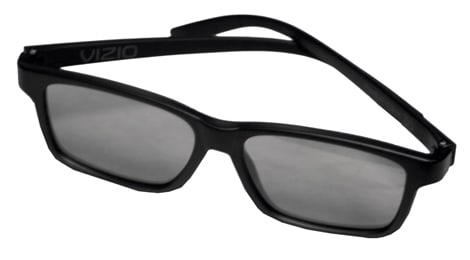
3D Effect & Experience
{{section_header}}{{section.name}}{{/section_header}}
There are two ways to access/make use of 3D content when dealing with a Samsung television (and this goes for most televisions, actually). The first is through "HD" or "Full" 3D, where a Blu-ray player with capability sends a 3D signal to the TV via HDMI cable, and 3D is triggered automatically. This is what is considered full 3D, and is the closest thing to IMAX 3D available for home electronics.
The second 3D option is by using the E550's 2D-to-3D conversion setting, which turns 2D content into "faux" 3D content--it gives it a mild depth of field. It's not the same caliber as full 3D, but it also doesn't have any problems with crosstalk. Not a bad way to scope out 3D-ish content without investing in a 3D Blu-ray player and its requisite discs.
Both of these settings look really good on the E550, and on most Samsung TVs right now. Samsung's 3D menu even gives users the option to alter their full 3D depth to be more or less "deep," so if content is varying in its quality, you can adjust to eliminate crosstalk or add more immersive 3D depth. The conversion works well, and Samsung usually throws in free glasses.
Samsung's 3D looks good, though they're neck and neck with LG to be the best in the industry.
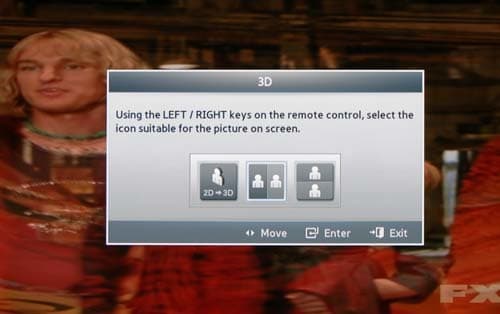
Some of the options in the 3D menu
The Samsung E550 comes with 2 free pairs of active shutter 3D glasses. They're packaged heavily to avoid damage, and their polarized lenses are covered in a screen so that they stay smudge and dust free until your children throw them in the sandbox. A small button at the top of the glasses will sync them with your TV, which then displays a confirmation message. If you don't see a confirmation message, something may be amiss--for example, the battery have been installed with incorrect polarity.
As to comfort, Samsung's glasses are quite light and flexible without feeling flimsy. The actual "eyewear" is sturdy, and the attachable arms are very springy, meaning they'll comfortable hug most craniums. Our one gripe with them is that their comfortability comes at a cost to eye space, and they don't fit very well over a pair of spectacles. If you wear glasses full time, you probably know that removing them to watch a 3D movie is a recipe for a serious headache. Hopefully, Samsung will make mild alterations to fix this problem.
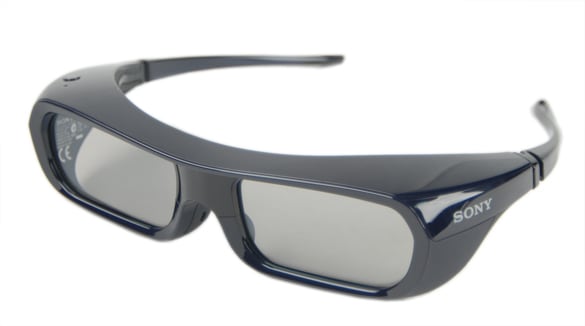
Yes, you will look like a dork with these on
3D Contrast
{{section_header}}{{section.name}}{{/section_header}}
3D televisions know you are watching them. Rather, they know that their viewers are wearing fancy sunglasses, and tend to level their whites/blacks to attempt to counteract the natural dimming that occurs--sometimes to good result, but mostly, to the clipping of a contrast ratio that is perfectly healthy in 2D.
That was the case with the E550. As you can see from the chart below, its contrast ratio drops considerably when viewed through 3D glasses. Its blacks get brighter (as it brightens to counteract the glasses), but--being a naturally dim plasma--its whites get cut by well over 50%, giving it a teeny 3D contrast ratio of 630:1.
If you're looking to watch the E550 in 3D, be prepared to lose your deep blacks and see some seriously dim highlights. If you want perfect contrast, just leave the 3D to IMAX.

3D Color
{{section_header}}{{section.name}}{{/section_header}}
The E550's 3D color temperature was slightly worse than its 2D temperature, in that its deviations from neutral swing to both the warmer and cooler side within the light input spectrum. It's a mild deviation, and the chance you'll notice it while your brain is being tricked into seeing three-dimensional Autobots is slim. This is an example of the current race to implement 3D without a loss in core performance; the E550 is showing some industry progress, but things still aren't perfect.
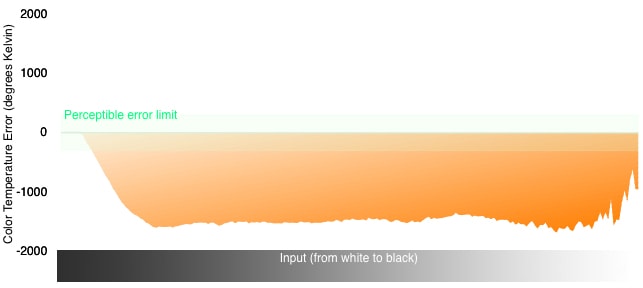
These are some very poor curves. The chart below illustrates that each color--red, green, blue--and the greyscale (black) are ramping in different ways, meaning that shades with the same light input as one another, between different colors, will appear brighter/darker than they should when contrasted. The red line ramps too quickly, and peaks early, meaning your brightest reds will be darker than reds that they should be lighter than; in short, your colors will be inaccurate, and the bumpiness of the lines means they'll shift between neighboring hues with sudden jumps, rather than smoothly the way that they should. This is not a good result, but is the trade a TV makes between quality color and 3D capability.
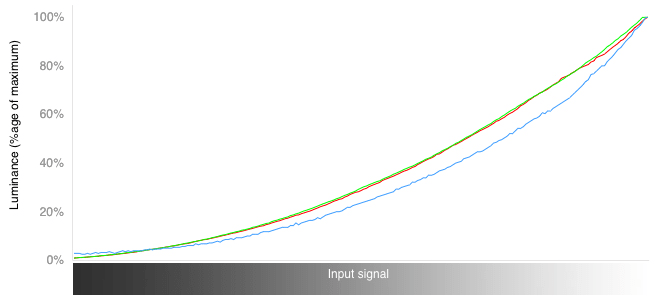
The chart below shows a comparison between the 2D and 3D color gamuts of the PN51E550D1. Our 2D color tests revealed that the E550's 2D gamut is fairly accurate--we might call it 50% accurate, compared to the rec. 709 standard. The chart below dictates around a 25% accuracy comparing the E550's 3D color gamut to the rec. 709 standard, with red, blue, and green each being oversaturated; it also missed the white point.
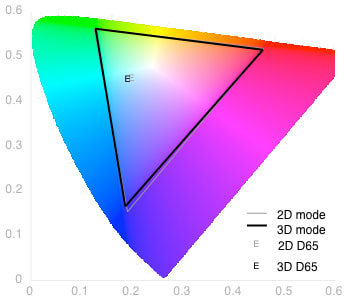
3D Crosstalk
{{section_header}}{{section.name}}{{/section_header}}
We saw very little in the way of crosstalk while viewing standard HD 3D content on the E550. Samsung's active 3D slider allowed us to decrease the perceived depth, which eliminated crosstalk entirely, but was also not as immersive. Increasing the slider beyond "0" (neutral) added depth, making middle and background images more impressive and convincing, but also increasing the foreground content by integral degrees depending on the extremity of increase. Though it will vary depending on content, we recommend leaving the slider at neutral to maintain optimum 3D while minimizing crosstalk to a bearable degree.
Software & Internet
Browser
{{section_header}}{{section.name}}{{/section_header}}
Samsung's standard browser is not much improved beyond any other browser available on other TVs, but their models do tend to have better processing speed than the average smart TV, which makes browsing the web a slightly less frustrating experience. Samsung's high-end ES8000 offers voice and gesture controls to make web browsing a little easier, but the E550's standard infrared can only do so much, so fast. Browsing could be much improved, but at least the shortcoming is within infrared technology, and not the TV itself.
Click here for more info on Samsung's web browser.
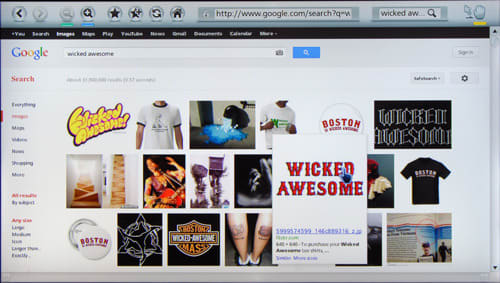
Apps
{{section_header}}{{section.name}}{{/section_header}}
The Smart Hub plays host to Samsung's own apps store, which features a heady variety of apps dealing with games, news, widgets, utilities, and social networking. A lot of the apps here are free, though anything that requires payment in real life (like HBO programming) will require a small fee in app form.
To learn more about Samsung's apps and their app store, click here.

Menu Interface
{{section_header}}{{section.name}}{{/section_header}}
Samsung's azure, opaque menu lines up along the left side of the screen, allowing for partially obscured viewing of background content while making changes within its vertical string of sub-menus: Picture, Sound, Channels, Network, Settings, and all of your standard HDTV options like gamma level, closed caption speed, picture size, or auto off. The sub-menus are navigated using the directional arrows on the remote, and should be fairly easy to wrangle for any cowboy who's used an HDTV in the last few years.
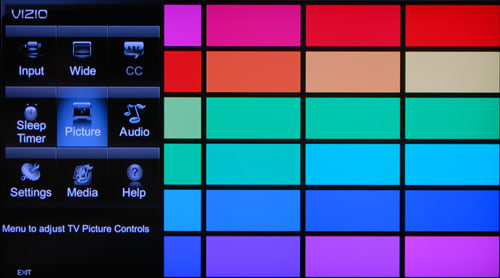
Users can alter the opacity of the menus, and have the option to backtrack through them using the "back" button, or to exit them completely using the "exit" button. You've also got the option to adjust 3D depth, audio options like surround mode and EQ settings, HDMI black level, the list goes on. There's no shortage of changes that can be made within Samsung's threshed out menus, but it's also easy to find and adjust the more important, overarching features of your TV experience.
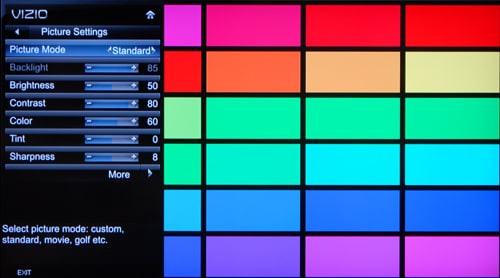
Conclusion
{{product.vanity}}
We feel that the Samsung PN51E550D1 is a great deal. Compared to the slightly less expensive E530 series, you're getting a lot more for your money. But as a standalone mid-range plasma, it brings a lot to the table.
With decent core performance, a sizable contrast ratio, decent 3D, and Samsung's excellent Smart Hub in tow, the PN51E550D1 is a valuable investment. Getting a 50+ inch plasma for a little over a grand is already a tempting deal, and its green-glass design aesthetic, internet features, low-cost power consumption, and overall flexibility feel like a laundry list of added bonuses.
While there are TVs with better core performance out there, the E550 (MSRP $1199) is solid in all areas, and we were impressed with its consistency and wide range of features. This would be a great budget TV to centralize a home theater set-up around, and in our opinion, is a smart investment.
Photo Gallery
{{photo_gallery "Design Landing Page Photo", "Front Tour Image", "Back Tour Image", "Sides Tour Image", "Connectivity Tour Image 1", "Connectivity Tour Image 2", "Stand Photo", "Controls Photo", "Remote Control Photo", "3D Landing Page Photo", "3D Menu Photo", "3D Glasses Photo", "Connectivity Extra Photo", "Software and Internet Landing Page Photo", "Menu Main Photo", "Menu 2 Photo", "Instruction Manual Photo", "Internet Features 1 Photo", "Internet Features 2 Photo", "Internet Features 3 Photo", "Local Media Playback 1 Photo", "Local Media Playback 2 Photo", "Browser 1 Photo", "Browser 2 Photo", "Browser 3 Photo", "Apps 1 Photo", "Apps 2 Photo", "Apps 3 Photo"}}
Ratings & Specs
{{manufacturer_specs_table}}
Meet the tester
Lee was Reviewed's point person for most television and home theater products from 2012 until early 2022. Lee received Level II certification in TV calibration from the Imaging Science Foundation in 2013. As Editor of the Home Theater vertical, Lee oversaw reviews of TVs, monitors, soundbars, and Bluetooth speakers. He also reviewed headphones, and has a background in music performance.
Checking our work.
Our team is here to help you buy the best stuff and love what you own. Our writers, editors, and experts obsess over the products we cover to make sure you're confident and satisfied. Have a different opinion about something we recommend? Email us and we'll compare notes.
Shoot us an email

